Welcome to my Sony A7 IV Memory Card Guide.
So far I’ve tested 20 CFexpress Type-A cards, 21 UHS-II and 3 UHS-I memory cards to see how they actually perform in-camera as opposed to what the label says.
This guide should help you to find the best memory cards for your needs and also help you to avoid spending more money than you really need to.

Table of Contents[Hide][Show]
- Quick In-Camera Card Speed Comparison
- Which Memory Cards are Supported?
CFexpress Type-A Memory Card Buffer Tests+−
- Nextorage NX-A1PRO CFexpress Type A
- Delkin Devices BLACK CFexpress Type A 4.0
- Angelbird AV PRO CFexpress 2.0 Type A SE
- Lexar Professional CFexpress Type-A Gold Series
- ProGrade Digital CFexpress 4.0 Type A Iridium
- OWC Atlas Pro CFexpress 4.0 Type A
- Pergear Standard CFexpress Type A
- Angelbird AV PRO CFexpress 4.0 Type A
- Sony CEA-G Tough CFexpress Type-A
- Lexar Professional CFexpress Type A Silver Series
- Delkin Devices BLACK CFexpress Type-A
- Delkin Devices POWER CFexpress Type-A
- ProGrade Digital CFexpress Type-A Cobalt
- Sony CEA-M Tough CFexpress Type A
- ProGrade Digital CFexpress 2.0 Type A Gold
- Exascend Essential CFexpress Type-A
- Pergear Prime CFexpress Type A
- Pergear Master 4.0 CFexpress Type A
- Nextorage NX-A1SE CFexpress Type A
- Nextorage NX-A2SE CFexpress Type A
UHS-II SD Memory Card Buffer Tests+−
- Delkin Devices BLACK V90 UHS-II SDXC
- Sony SF-G Tough UHS-II SDXC
- Delkin Devices 64GB POWER UHS-II SDXC
- SanDisk Extreme Pro UHS-II SDXC (300/300)
- OWC Atlas Ultra UHS-II SDXC
- Nextorage NX-F2PRO Series UHS-II SDXC
- Lexar Professional 2000X UHS-II
- Kingston Canvas React Plus UHS-II SDXC
- ProGrade V90 UHS-II
- Integral UltimaPro X2 UHS-II SDXC
- PNY X-PRO 90 UHS-II SDXC
- Exascend Catalyst UHS-II SDXC
- Angelbird AV Pro Mk 2 V90
- Transcend SD 700S UHS-II
- Nextorage NX-F2SE Series UHS-II SDXC
- Sony SF-M Tough UHS-II
- Sony SF-M UHS-II
- ProGrade V60 UHS-II
- Angelbird AV Pro MK2 V60 UHS-II SDXC
- Sony SF-E UHS-II
- Lexar Professional 1667X UHS-II
- Memory Cards for Recording Video
- Memory Cards for S&Q Motion Shooting
- What Size Memory Card Do You Need?
- How Many Images Can Be Recorded on a Memory Card?
- Movie Record Times
- Simultaneous Recording Slot 1 + Slot 2
- Sort RAW / JPEG
- Dual Card Setup Guide
- Summary
- FAQs
- Sony A7 IV Guides & Resources
Quick In-Camera Card Speed Comparison
Here are my in-camera card speed comparison results for all of the CFexpress Type-A and UHS-II SD cards that I’ve tested so far in my Sony A7 IV with firmware 5.0.
If you scroll down a little further you will find my complete buffer test results for each memory card tested.
Best CFexpress Type-A Memory Cards for Sony A7 IV
Because the A7IV only writes at around 420 MB/s when shooting uncompressed RAW images none of the CFexpress Type A cards tested here will hit the buffer.
To see these cards tested a little harder please visit my Sony A1 Memory Card Guide. I’ve listed the cards here based on how they perform in my A1.
Best UHS-II SD Memory Cards for Sony A7 IV
These tests were done using my Sony A7 IV with firmware version 5.0. Unlike the CFexpress cards you will hit the buffer when using UHS-II cards.
Sony A7 IV Price Check at: B&H Photo
If you find this article helpful then you may also like my Sony A7 IV Accessories Guide and Lenses Guide.
Sony A7 IV Forum & Facebook Group
If you are looking for further help and advice on the a7 IV or would simply like to share your photos and videos, then please head over to our friendly full-frame Forum. If you prefer Facebook then we also run the Sony A7 IV Shooters Group.
Which Memory Cards are Supported?
The Sony A7IV has two memory card slots, here are the cards that each slot supports:
- Slot 1: CFexpress Type A (2.0 & 4.0) and UHS-I and UHS-II (SDHC/SDXC) SD cards
- Slot 2: Only UHS-I and UHS-II (SD/SDHC/SDXC) cards
CFexpress Type A 4.0 cards will work in the A7IV because they are backwards compatible with the 2.0 standard, but you will not be able to take advantage of 4.0 speeds in-camera. That said, due to the maximum 10 fps drive speed and 33 megapixel sensor the 2.0 cards are fast enough.

CFexpress Type-A Memory Card Buffer Tests
If you shoot a lot of continuous bursts and demand the fastest buffer clearing times then you’ll want to use a CFexpress Type-A card.
Here are all of the cards that I have tested so far in my A7IV with firmware version 5.00.
When shooting with the A7IV all of the CFexpress cards here are comfortably fast enough to allow you to shoot continuously for well over 500 shots and clear the buffer in a couple of seconds.
I don’t take more than 500 shots to avoid trashing my mechanical shutter and I don’t think many people will be shooting 500 shot bursts with the A7IV anyway.
To see these cards tested a little harder please visit my Sony A1 Memory Card Guide.
Nextorage NX-A1PRO CFexpress Type A

- CFexpress Standard: 2.0
- Max Read Speed: 950 MB/s
- Max Write Speed: 600 MB/s (40 GB) / 950 MB/s (80/160/320/640 GB)
- Max Sustained Read Speed: NA
- Max Sustained Write Speed: 550 MB/s (40 GB) / 850 MB/s (80/160/320/640 GB)
- Minimum Sustained Write Speed: 400 MB/s
- Video Performance Guarantee (VPG): 400
- Capacities: 40 GB / 80 GB / 160 GB / 320 GB / 640 GB
In-Camera Speed & Buffer Test Results
Here are my in-camera speed test results using a 160 GB card:
Drive Mode Hi+ (Max 10fps)
Please note that the maximum speed of 10 fps is only possible in compressed RAW, JPEG and HEIF file formats.
| Image Type | Shots Before Hitting Buffer | Time to Clear Buffer (Seconds) |
|---|---|---|
| Uncompressed RAW (70.3MB) – 6 fps | Over 500 | < 2.00s |
| Compressed RAW (36.6MB) – 10 fps | Over 500 | < 2.00s |
| Lossless Compressed RAW L (40.5MB) – 6 fps | Over 500 | < 2.00s |
| JPEG Extra Fine (24MB) – 10 fps | Over 500 | < 2.00s |
Check Price & Reviews: Nextorage NX-A1PRO CFexpress Type A
At: Amazon | B&H Photo | Memory Wolf UK
Delkin Devices BLACK CFexpress Type A 4.0

- CFexpress Standard: 4.0
- Max Read Speed: 1830 MB/s
- Max Write Speed: 1710 MB/s (480GB) / 1740 MB/s (960GB)
- Max Sustained Write Speed: 500 MB/s
- Minimum Sustained Write Speed: 200 MB/s
- Video Performance Guarantee (VPG): 200
- Capacities: 480 GB / 960 GB
In-Camera Speed & Buffer Test Results
Here are my in-camera speed test results using a 480 GB card:
Drive Mode Hi+ (Max 10fps)
Please note that the maximum speed of 10 fps is only possible in compressed RAW, JPEG and HEIF file formats.
| Image Type | Shots Before Hitting Buffer | Time to Clear Buffer (Seconds) |
|---|---|---|
| Uncompressed RAW (70.3MB) – 6 fps | Over 500 | < 2.00s |
| Compressed RAW (36.6MB) – 10 fps | Over 500 | < 2.00s |
| Lossless Compressed RAW L (40.5MB) – 6 fps | Over 500 | < 2.00s |
| JPEG Extra Fine (24MB) – 10 fps | Over 500 | < 2.00s |
Check Price & Reviews: Delkin Devices BLACK CFexpress Type A 4.0
At: Amazon | B&H Photo | Memory Wolf UK
Angelbird AV PRO CFexpress 2.0 Type A SE

- CFexpress Standard: 2.0
- Max Read Speed: 820 MB/s
- Max Write Speed: 730 MB/s
- Max Sustained Read Speed: 750 MB/s
- Max Sustained Write Speed: 650 MB/s
- Minimum Sustained Write Speed: 200 MB/s
- Video Performance Guarantee (VPG): 200
- Capacities: 160 GB / 330 GB
In-Camera Speed & Buffer Test Results
Here are my in-camera speed test results using a 160 GB card:
Drive Mode Hi+ (Max 10fps)
Please note that the maximum speed of 10 fps is only possible in compressed RAW, JPEG and HEIF file formats.
| Image Type | Shots Before Hitting Buffer | Time to Clear Buffer (Seconds) |
|---|---|---|
| Uncompressed RAW (70.3MB) – 6 fps | Over 500 | < 2.00s |
| Compressed RAW (36.6MB) – 10 fps | Over 500 | < 2.00s |
| Lossless Compressed RAW L (40.5MB) – 6 fps | Over 500 | < 2.00s |
| JPEG Extra Fine (24MB) – 10 fps | Over 500 | < 2.00s |
Check Price & Reviews: Angelbird AV PRO CFexpress 2.0 Type A SE
At: Amazon | B&H Photo | Memory Wolf UK
Lexar Professional CFexpress Type-A Gold Series
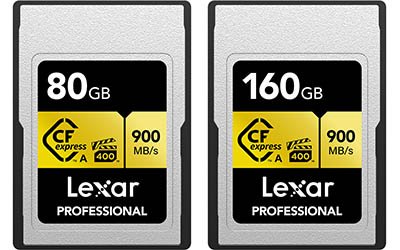
- CFexpress Standard: 2.0
- Max Read Speed: 900 MB/s
- Max Write Speed: 700 MB/s
- Max Sustained Read Speed: xx MB/s
- Max Sustained Write Speed: 400 MB/s
- Minimum Sustained Write Speed: 400 MB/s
- Video Performance Guarantee (VPG): 400
- Capacities: 80 GB / 160 GB / 320 GB
In-Camera Speed & Buffer Test Results
Here are my in-camera speed test results using a 160 GB card:
Drive Mode Hi+ (Max 10fps)
Please note that the maximum speed of 10 fps is only possible in compressed RAW, JPEG and HEIF file formats.
| Image Type | Shots Before Hitting Buffer | Time to Clear Buffer (Seconds) |
|---|---|---|
| Uncompressed RAW (70.3MB) – 6 fps | Over 500 | < 2.00s |
| Compressed RAW (36.6MB) – 10 fps | Over 500 | < 2.00s |
| Lossless Compressed RAW L (40.5MB) – 6 fps | Over 500 | < 2.00s |
| JPEG Extra Fine (24MB) – 10 fps | Over 500 | < 2.00s |
ProGrade Digital CFexpress 4.0 Type A Iridium

- CFexpress Standard: 4.0
- Max Read Speed: 1800 MB/s
- Max Write Speed: 1700 MB/s
- Max Sustained Read Speed: NA
- Max Sustained Write Speed: 800 MB/s (480 GB) / 1450 MB/s (960 GB)
- Minimum Sustained Write Speed: 200 MB/s
- Video Performance Guarantee (VPG): 200
- Capacities: 480 GB / 960 GB
In-Camera Speed & Buffer Test Results
Here are my in-camera speed test results using a 480 GB card:
Drive Mode Hi+ (Max 10fps)
Please note that the maximum speed of 10 fps is only possible in compressed RAW, JPEG and HEIF file formats.
| Image Type | Shots Before Hitting Buffer | Time to Clear Buffer (Seconds) |
|---|---|---|
| Uncompressed RAW (70.3MB) – 6 fps | Over 500 | < 2.00s |
| Compressed RAW (36.6MB) – 10 fps | Over 500 | < 2.00s |
| Lossless Compressed RAW L (40.5MB) – 6 fps | Over 500 | < 2.00s |
| JPEG Extra Fine (24MB) – 10 fps | Over 500 | < 2.00s |
OWC Atlas Pro CFexpress 4.0 Type A

- CFexpress Standard: 4.0
- Max Read Speed: 1850 MB/s
- Max Write Speed: 1700 MB/s
- Max Sustained Read Speed: NA
- Max Sustained Write Speed: 400 MB/s
- Minimum Sustained Write Speed: 200 MB/s
- Video Performance Guarantee (VPG): 200
- Capacities: 240 GB / 480 GB / 960 GB
In-Camera Speed & Buffer Test Results
Here are my in-camera speed test results using a 240 GB card:
Drive Mode Hi+ (Max 10fps)
Please note that the maximum speed of 10 fps is only possible in compressed RAW, JPEG and HEIF file formats.
| Image Type | Shots Before Hitting Buffer | Time to Clear Buffer (Seconds) |
|---|---|---|
| Uncompressed RAW (70.3MB) – 6 fps | Over 500 | < 2.00s |
| Compressed RAW (36.6MB) – 10 fps | Over 500 | < 2.00s |
| Lossless Compressed RAW L (40.5MB) – 6 fps | Over 500 | < 2.00s |
| JPEG Extra Fine (24MB) – 10 fps | Over 500 | < 2.00s |
Pergear Standard CFexpress Type A

- CFexpress Standard: 2.0
- Max Read Speed: 780 MB/s (256GB) / 800 MB/s (512 GB)
- Max Write Speed: 780 MB/s
- Max Sustained Read Speed: NA
- Max Sustained Write Speed: NA
- Minimum Sustained Write Speed: NA
- Video Performance Guarantee (VPG): NA
- Capacities: 256 GB / 256 GB
In-Camera Speed & Buffer Test Results
Here are my in-camera speed test results using a 256 GB card:
Drive Mode Hi+ (Max 10fps)
Please note that the maximum speed of 10 fps is only possible in compressed RAW, JPEG and HEIF file formats.
| Image Type | Shots Before Hitting Buffer | Time to Clear Buffer (Seconds) |
|---|---|---|
| Uncompressed RAW (70.3MB) – 6 fps | Over 500 | < 2.00s |
| Compressed RAW (36.6MB) – 10 fps | Over 500 | < 2.00s |
| Lossless Compressed RAW L (40.5MB) – 6 fps | Over 500 | < 2.00s |
| JPEG Extra Fine (24MB) – 10 fps | Over 500 | < 2.00s |
Check Price & Reviews: Pergear Standard CFexpress Type A
At: Amazon
Angelbird AV PRO CFexpress 4.0 Type A
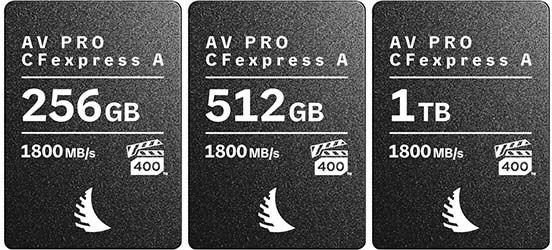
- CFexpress Standard: 4.0
- Max Read Speed: 1800 MB/s
- Max Write Speed: 1650 MB/s
- Max Sustained Read Speed: 1700 MB/s
- Max Sustained Write Speed: 800 MB/s
- Minimum Sustained Write Speed: 400 MB/s
- Video Performance Guarantee (VPG): 400
- Capacities: 256 GB / 512 GB / 1 TB
In-Camera Speed & Buffer Test Results
Here are my in-camera speed test results using a 256 GB card:
Drive Mode Hi+ (Max 10fps)
Please note that the maximum speed of 10 fps is only possible in compressed RAW, JPEG and HEIF file formats.
| Image Type | Shots Before Hitting Buffer | Time to Clear Buffer (Seconds) |
|---|---|---|
| Uncompressed RAW (70.3MB) – 6 fps | Over 500 | < 2.00s |
| Compressed RAW (36.6MB) – 10 fps | Over 500 | < 2.00s |
| Lossless Compressed RAW L (40.5MB) – 6 fps | Over 500 | < 2.00s |
| JPEG Extra Fine (24MB) – 10 fps | Over 500 | < 2.00s |
This card appears to be a little temperamental in the A7RV. Sometimes it will shoot around 200 uncompressed RAW images before filling the buffer, other times it will manage around 250.
Check Price & Reviews: Angelbird AV PRO CFexpress 4.0 Type A
At: Amazon | B&H Photo | Memory Wolf UK
Sony CEA-G Tough CFexpress Type-A
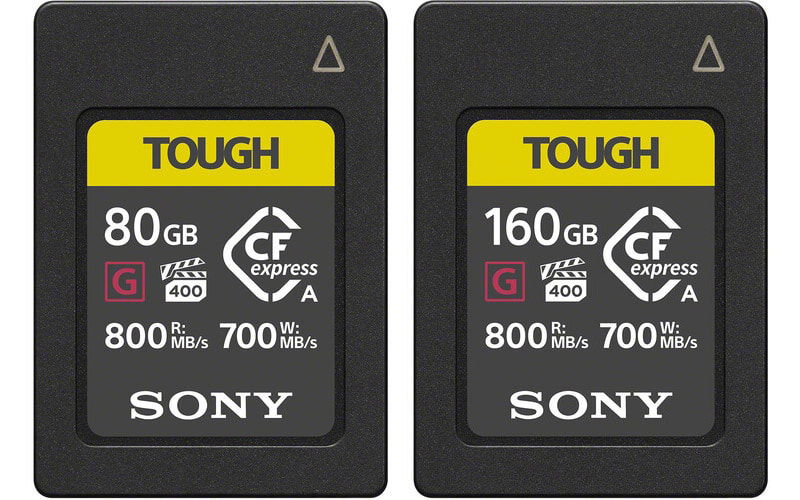
- CFexpress Standard: 2.0
- Max Read Speed: 800 MB/s
- Max Write Speed: 700 MB/s
- Max Sustained Read Speed: NA
- Max Sustained Write Speed: NA
- Minimum Sustained Write Speed: 400 MB/s
- Video Performance Guarantee (VPG): 400
- Capacities: 80 GB / 160 GB / 320 GB / 640 GB
In-Camera Speed & Buffer Test Results
Here are my in-camera speed test results using a 80 GB card:
Drive Mode Hi+ (Max 10fps)
Please note that the maximum speed of 10 fps is only possible in compressed RAW, JPEG and HEIF file formats.
| Image Type | Shots Before Hitting Buffer | Time to Clear Buffer (Seconds) |
|---|---|---|
| Uncompressed RAW (70.3MB) – 6 fps | Over 500 | < 2.00s |
| Compressed RAW (36.6MB) – 10 fps | Over 500 | < 2.00s |
| Lossless Compressed RAW L (40.5MB) – 6 fps | Over 500 | < 2.00s |
| JPEG Extra Fine (24MB) – 10 fps | Over 500 | < 2.00s |
Lexar Professional CFexpress Type A Silver Series

- CFexpress Standard: 2.0
- Max Read Speed: 800 MB/s
- Max Write Speed: 700 MB/s
- Max Sustained Read Speed: NA MB/s
- Max Sustained Write Speed: 600 MB/s
- Minimum Sustained Write Speed: 200 MB/s
- Video Performance Guarantee (VPG): 200
- Capacities: 160 GB / 320 GB
In-Camera Speed & Buffer Test Results
Here are my in-camera speed test results using a 260 GB card:
Drive Mode Hi+ (Max 10fps)
Please note that the maximum speed of 10 fps is only possible in compressed RAW, JPEG and HEIF file formats.
| Image Type | Shots Before Hitting Buffer | Time to Clear Buffer (Seconds) |
|---|---|---|
| Uncompressed RAW (70.3MB) – 6 fps | Over 500 | < 2.00s |
| Compressed RAW (36.6MB) – 10 fps | Over 500 | < 2.00s |
| Lossless Compressed RAW L (40.5MB) – 6 fps | Over 500 | < 2.00s |
| JPEG Extra Fine (24MB) – 10 fps | Over 500 | < 2.00s |
Check Price & Reviews: Lexar Professional CFexpress Type A Silver Series
At: Amazon | B&H Photo
Delkin Devices BLACK CFexpress Type-A

- CFexpress Standard: 2.0
- Max Read Speed: 880 MB/s
- Max Write Speed: 790 MB/s
- Max Sustained Read Speed: NA
- Max Sustained Write Speed: NA
- Minimum Sustained Write Speed: 400 MB/s
- Video Performance Guarantee (VPG): 400
- Capacities: 80 GB / 160 GB
In-Camera Speed & Buffer Test Results
Here are my in-camera speed test results using a 160 GB card:
Drive Mode Hi+ (Max 10fps)
Please note that the maximum speed of 10 fps is only possible in compressed RAW, JPEG and HEIF file formats.
| Image Type | Shots Before Hitting Buffer | Time to Clear Buffer (Seconds) |
|---|---|---|
| Uncompressed RAW (70.3MB) – 6 fps | Over 500 | < 2.00s |
| Compressed RAW (36.6MB) – 10 fps | Over 500 | < 2.00s |
| Lossless Compressed RAW L (40.5MB) – 6 fps | Over 500 | < 2.00s |
| JPEG Extra Fine (24MB) – 10 fps | Over 500 | < 2.00s |
Check Price & Reviews: Delkin Devices BLACK 2.0 CFexpress Type-A
At: Memory Wolf UK
Delkin Devices POWER CFexpress Type-A
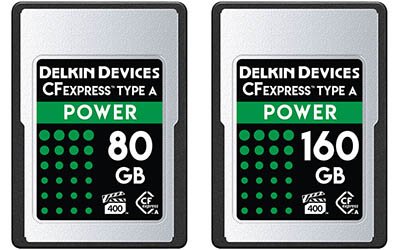
- CFexpress Standard: 2.0
- Max Read Speed: 880 MB/s
- Max Write Speed: 790 MB/s
- Max Sustained Read Speed: NA
- Max Sustained Write Speed: NA
- Minimum Sustained Write Speed: 400 MB/s
- Video Performance Guarantee (VPG): 400
- Capacities: 80 GB / 160 GB
In-Camera Speed & Buffer Test Results
Here are my in-camera speed test results using a 80 GB card:
Drive Mode Hi+ (Max 10fps)
Please note that the maximum speed of 10 fps is only possible in compressed RAW, JPEG and HEIF file formats.
| Image Type | Shots Before Hitting Buffer | Time to Clear Buffer (Seconds) |
|---|---|---|
| Uncompressed RAW (70.3MB) – 6 fps | Over 500 | < 2.00s |
| Compressed RAW (36.6MB) – 10 fps | Over 500 | < 2.00s |
| Lossless Compressed RAW L (40.5MB) – 6 fps | Over 500 | < 2.00s |
| JPEG Extra Fine (24MB) – 10 fps | Over 500 | < 2.00s |
Check Price & Reviews: Delkin Devices POWER CFexpress Type-A 2.0
At: Amazon | B&H Photo | Memory Wolf UK
ProGrade Digital CFexpress Type-A Cobalt
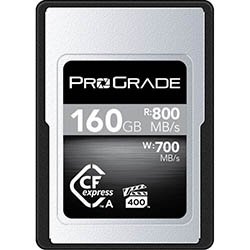
- CFexpress Standard: 2.0
- Max Read Speed: 800 MB/s
- Max Write Speed: 700 MB/s
- Max Sustained Read Speed: NA
- Max Sustained Write Speed: NA
- Minimum Sustained Write Speed: 400 MB/s
- Video Performance Guarantee (VPG): 400
- Capacities: 160 GB
In-Camera Speed & Buffer Test Results
Here are my in-camera speed test results using a 160 GB card:
Drive Mode Hi+ (Max 10fps)
Please note that the maximum speed of 10 fps is only possible in compressed RAW, JPEG and HEIF file formats.
| Image Type | Shots Before Hitting Buffer | Time to Clear Buffer (Seconds) |
|---|---|---|
| Uncompressed RAW (70.3MB) – 6 fps | Over 500 | < 2.00s |
| Compressed RAW (36.6MB) – 10 fps | Over 500 | < 2.00s |
| Lossless Compressed RAW L (40.5MB) – 6 fps | Over 500 | < 2.00s |
| JPEG Extra Fine (24MB) – 10 fps | Over 500 | < 2.00s |
Sony CEA-M Tough CFexpress Type A

- CFexpress Standard: 2.0
- Max Read Speed: 800 MB/s
- Max Write Speed: 700 MB/s
- Max Sustained Read Speed: NA
- Max Sustained Write Speed: NA
- Minimum Sustained Write Speed: 200 MB/s
- Video Performance Guarantee (VPG): 200
- Capacities: 960 GB / 1920 GB
In-Camera Speed & Buffer Test Results
Here are my in-camera speed test results using a 960 GB card:
Drive Mode Hi+ (Max 10fps)
Please note that the maximum speed of 10 fps is only possible in compressed RAW, JPEG and HEIF file formats.
| Image Type | Shots Before Hitting Buffer | Time to Clear Buffer (Seconds) |
|---|---|---|
| Uncompressed RAW (70.3MB) – 6 fps | Over 500 | < 2.00s |
| Compressed RAW (36.6MB) – 10 fps | Over 500 | < 2.00s |
| Lossless Compressed RAW L (40.5MB) – 6 fps | Over 500 | < 2.00s |
| JPEG Extra Fine (24MB) – 10 fps | Over 500 | < 2.00s |
ProGrade Digital CFexpress 2.0 Type A Gold

- CFexpress Standard: 2.0
- Max Read Speed: 900 MB/s
- Max Write Speed: 800 MB/s
- Max Sustained Read Speed: NA
- Max Sustained Write Speed: 450 MB/s (120 GB) / 600 MB/s (240GB/480GB/960GB)
- Minimum Sustained Write Speed: 200 MB/s
- Video Performance Guarantee (VPG): 200
- Capacities: 120 GB / 240 GB / 480 GB / 960 GB
In-Camera Speed & Buffer Test Results
Here are my in-camera speed test results using a 120 GB card:
Drive Mode Hi+ (Max 10fps)
Please note that the maximum speed of 10 fps is only possible in compressed RAW, JPEG and HEIF file formats.
| Image Type | Shots Before Hitting Buffer | Time to Clear Buffer (Seconds) |
|---|---|---|
| Uncompressed RAW (70.3MB) – 6 fps | Over 500 | < 2.00s |
| Compressed RAW (36.6MB) – 10 fps | Over 500 | < 2.00s |
| Lossless Compressed RAW L (40.5MB) – 6 fps | Over 500 | < 2.00s |
| JPEG Extra Fine (24MB) – 10 fps | Over 500 | < 2.00s |
Exascend Essential CFexpress Type-A
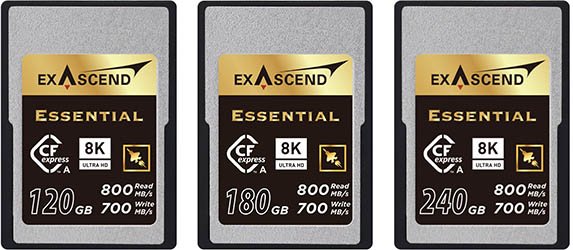
- CFexpress Standard: 2.0
- Max Read Speed: 800 MB/s
- Max Write Speed: 700 MB/s
- Max Sustained Read Speed: NA
- Max Sustained Write Speed: NA
- Minimum Sustained Write Speed: 200 MB/s
- Video Performance Guarantee (VPG): 200
- Capacities: 120 GB / 180 GB / 240 GB
In-Camera Speed & Buffer Test Results
Here are my in-camera speed test results using a 240 GB card:
Drive Mode Hi+ (Max 10fps)
Please note that the maximum speed of 10 fps is only possible in compressed RAW, JPEG and HEIF file formats.
| Image Type | Shots Before Hitting Buffer | Time to Clear Buffer (Seconds) |
|---|---|---|
| Uncompressed RAW (70.3MB) – 6 fps | Over 500 | < 2.00s |
| Compressed RAW (36.6MB) – 10 fps | Over 500 | < 2.00s |
| Lossless Compressed RAW L (40.5MB) – 6 fps | Over 500 | < 2.00s |
| JPEG Extra Fine (24MB) – 10 fps | Over 500 | < 2.00s |
Pergear Prime CFexpress Type A

- CFexpress Standard: 2.0
- Max Read Speed: 800 MB/s (80GB / 1TB) / 880 MB/s (260GB / 520GB)
- Max Write Speed: 600 MB/s (80GB) / 400 MB/s (260GB / 520GB) / 700 MB/s (1 TB)
- Max Sustained Read Speed: NA
- Max Sustained Write Speed: NA
- Minimum Sustained Write Speed: NA
- Video Performance Guarantee (VPG): NA
- Capacities: 80 GB / 260 GB / 520 GB / 1 TB
In-Camera Speed & Buffer Test Results
Here are my in-camera speed test results using a 260 GB card:
Drive Mode Hi+ (Max 10fps)
Please note that the maximum speed of 10 fps is only possible in compressed RAW, JPEG and HEIF file formats.
| Image Type | Shots Before Hitting Buffer | Time to Clear Buffer (Seconds) |
|---|---|---|
| Uncompressed RAW (70.3MB) – 6 fps | Over 500 | < 2.00s |
| Compressed RAW (36.6MB) – 10 fps | Over 500 | < 2.00s |
| Lossless Compressed RAW L (40.5MB) – 6 fps | Over 500 | < 2.00s |
| JPEG Extra Fine (24MB) – 10 fps | Over 500 | < 2.00s |
Pergear Master 4.0 CFexpress Type A

- CFexpress Standard: 4.0
- Max Read Speed: 1780 MB/s
- Max Write Speed: 1600 MB/s
- Max Sustained Read Speed: NA
- Max Sustained Write Speed: 700 MB/s
- Minimum Sustained Write Speed:
- Video Performance Guarantee (VPG):
- Capacities: 256 GB / 512 GB / 1 TB
In-Camera Speed & Buffer Test Results
Here are my in-camera speed test results using a 256 GB card:
Drive Mode Hi+ (Max 10fps)
Please note that the maximum speed of 10 fps is only possible in compressed RAW, JPEG and HEIF file formats.
| Image Type | Shots Before Hitting Buffer | Time to Clear Buffer (Seconds) |
|---|---|---|
| Uncompressed RAW (70.3MB) – 6 fps | Over 500 | < 2.00s |
| Compressed RAW (36.6MB) – 10 fps | Over 500 | < 2.00s |
| Lossless Compressed RAW L (40.5MB) – 6 fps | Over 500 | < 2.00s |
| JPEG Extra Fine (24MB) – 10 fps | Over 500 | < 2.00s |
Check Price & Reviews: Pergear Master 4.0 CFexpress Type A
At: Amazon
Nextorage NX-A1SE CFexpress Type A

- CFexpress Standard: 2.0
- Max Read Speed: 950 MB/s
- Max Write Speed: 950 MB/s
- Max Sustained Read Speed: NA
- Max Sustained Write Speed: NA
- Minimum Sustained Write Speed: 400 MB/s
- Video Performance Guarantee (VPG): 200
- Capacities: 480 GB / 960 GB / 1920 GB
In-Camera Speed & Buffer Test Results
Here are my in-camera speed test results using a 480 GB card:
Drive Mode Hi+ (Max 10fps)
Please note that the maximum speed of 10 fps is only possible in compressed RAW, JPEG and HEIF file formats.
| Image Type | Shots Before Hitting Buffer | Time to Clear Buffer (Seconds) |
|---|---|---|
| Uncompressed RAW (70.3MB) – 6 fps | Over 500 | < 2.00s |
| Compressed RAW (36.6MB) – 10 fps | Over 500 | < 2.00s |
| Lossless Compressed RAW L (40.5MB) – 6 fps | Over 500 | < 2.00s |
| JPEG Extra Fine (24MB) – 10 fps | Over 500 | < 2.00s |
Check Price & Reviews: Nextorage NX-A1SE CFexpress Type A
At: Amazon | Memory Wolf UK
Nextorage NX-A2SE CFexpress Type A

- CFexpress Standard: 4.0
- Max Read Speed: 1900 MB/s
- Max Write Speed: 1700 MB/s
- Max Sustained Read Speed: NA
- Max Sustained Write Speed: NA
- Minimum Sustained Write Speed: 400 MB/s (256GB) / 850 MB/s (512GB) / 1500 MB/s (1024GB)
- Video Performance Guarantee (VPG): 200
- Capacities: 256 GB / 512 GB / 1024 GB
In-Camera Speed & Buffer Test Results
Here are my in-camera speed test results using a 256 GB card:
Drive Mode Hi+ (Max 10fps)
Please note that the maximum speed of 10 fps is only possible in compressed RAW, JPEG and HEIF file formats.
| Image Type | Shots Before Hitting Buffer | Time to Clear Buffer (Seconds) |
|---|---|---|
| Uncompressed RAW (70.3MB) – 6 fps | Over 500 | < 2.00s |
| Compressed RAW (36.6MB) – 10 fps | Over 500 | < 2.00s |
| Lossless Compressed RAW L (40.5MB) – 6 fps | Over 500 | < 2.00s |
| JPEG Extra Fine (24MB) – 10 fps | Over 500 | < 2.00s |
Check Price & Reviews: Nextorage NX-A2SE CFexpress Type A
At: Amazon
UHS-II SD Memory Card Buffer Tests
If you don’t shoot many continuous bursts then you don’t really need to purchase CFexpress cards because UHS-II SD cards will be fast enough. The main benefit to the faster CFexpress cards for single shot shooters would be copying files over to your computer faster.
Here are all of the UHS-II SD cards that I have tested in my A7IV so far.
Delkin Devices BLACK V90 UHS-II SDXC

- Bus Type: UHS-II
- Maximum Read Speed: 300 MB/s
- Maximum Write Speed: 250 MB/s
- Minimum Write Speed: 90 MB/s
- Video Rating: V90
- Capacities: 64GB, 128GB, 256GB, 512GB
In-Camera Speed & Buffer Test Results
Here are my in-camera speed test results using a 64 GB card:
Drive Mode Hi+ (Max 10fps)
Please note that the maximum speed of 10 fps is only possible in compressed RAW, JPEG and HEIF file formats.
| Image Type | Shots Before Hitting Buffer | Time to Clear Buffer (Seconds) |
|---|---|---|
| Uncompressed RAW (70.3MB) – 6 fps | 23 | 4.30s |
| Compressed RAW (36.6MB) – 10 fps | 54 | 4.18s |
| Lossless Compressed RAW L (40.5MB) – 6 fps | 109 | 2.71s |
| JPEG Extra Fine (24MB) – 10 fps | 132 | 2.61s |
Check Price & Reviews: Delkin Devices BLACK V90 UHS-II SDXC
At: Amazon | B&H Photo | Memory Wolf UK
Sony SF-G Tough UHS-II SDXC

- Bus Type: UHS-II
- Maximum Read Speed: 300 MB/s
- Maximum Write Speed: 299 MB/s
- Minimum Write Speed: 90 MB/s
- Video Rating: V90
- Capacities: 64GB, 128GB, 256GB
In-Camera Speed & Buffer Test Results
Here are my in-camera speed test results using a 64 GB card:
Drive Mode Hi+ (Max 10fps)
Please note that the maximum speed of 10 fps is only possible in compressed RAW, JPEG and HEIF file formats.
| Image Type | Shots Before Hitting Buffer | Time to Clear Buffer (Seconds) |
|---|---|---|
| Uncompressed RAW (70.3MB) – 6 fps | 23 | 4.30s |
| Compressed RAW (36.6MB) – 10 fps | 54 | 4.19s |
| Lossless Compressed RAW L (40.5MB) – 6 fps | 110 | 2.70s |
| JPEG Extra Fine (24MB) – 10 fps | 132 | 2.61s |
Very Important Note: Old versions of these cards do not work with the A7 IV. I get a message that says: “Unable to use Memory Card. Slot 1″. Sony has a replacement program for older versions of these cards due to VSC mode (Video Speed Class) issues where recorded footage on the card may be damaged or may not be recorded optimally. I have three cards that I never got around to sending back that don’t work at all in the a7 IV, but work fine in all of my other Sony cameras. New cards purchased from the second half of 2020 should not be affected, and my cards purchased this year work fine. You can find out if your cards are affected by checking this article.
Delkin Devices 64GB POWER UHS-II SDXC
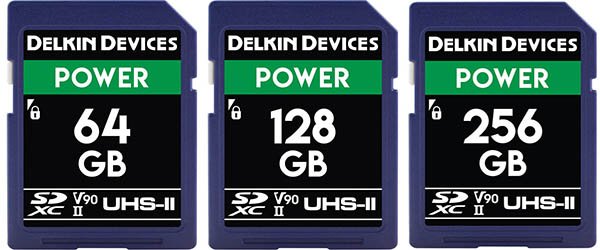
- Bus Type: UHS-II
- Maximum Read Speed: 300 MB/s
- Maximum Write Speed: 250 MB/s
- Minimum Write Speed: 90 MB/s
- Video Rating: V90
- Capacities: 64GB, 128GB, 256GB
In-Camera Speed & Buffer Test Results
Here are my in-camera speed test results using a 64 GB card:
Drive Mode Hi+ (Max 10fps)
Please note that the maximum speed of 10 fps is only possible in compressed RAW, JPEG and HEIF file formats.
| Image Type | Shots Before Hitting Buffer | Time to Clear Buffer (Seconds) |
|---|---|---|
| Uncompressed RAW (70.3MB) – 6 fps | 23 | 4.30s |
| Compressed RAW (36.6MB) – 10 fps | 54 | 4.18s |
| Lossless Compressed RAW L (40.5MB) – 6 fps | 109 | 2.71s |
| JPEG Extra Fine (24MB) – 10 fps | 132 | 2.61s |
SanDisk Extreme Pro UHS-II SDXC (300/300)

- Bus Type: UHS-II
- Maximum Read Speed: 300 MB/s
- Maximum Write Speed: 300 MB/s
- Minimum Write Speed: 90 MB/s
- Video Rating: V90
- Capacities: 64GB, 128GB, 256GB, 512GB
In-Camera Speed & Buffer Test Results
Here are my in-camera speed test results using a 64 GB card:
Drive Mode Hi+ (Max 10fps)
Please note that the maximum speed of 10 fps is only possible in compressed RAW, JPEG and HEIF file formats.
| Image Type | Shots Before Hitting Buffer | Time to Clear Buffer (Seconds) |
|---|---|---|
| Uncompressed RAW (70.3MB) – 6 fps | 23 | 4.30s |
| Compressed RAW (36.6MB) – 10 fps | 54 | 4.19s |
| Lossless Compressed RAW L (40.5MB) – 6 fps | 108 | 2.71s |
| JPEG Extra Fine (24MB) – 10 fps | 132 | 2.63s |
OWC Atlas Ultra UHS-II SDXC

- Bus Type: UHS-II
- Maximum Read Speed: 300 MB/s
- Maximum Write Speed: 250 MB/s
- Minimum Write Speed: 90 MB/s
- Video Rating: V90
- Capacities: 64GB, 128GB, 256GB, 512GB
In-Camera Speed & Buffer Test Results
Here are my in-camera speed test results using a 128 GB card:
Drive Mode Hi+ (Max 10fps)
Please note that the maximum speed of 10 fps is only possible in compressed RAW, JPEG and HEIF file formats.
| Image Type | Shots Before Hitting Buffer | Time to Clear Buffer (Seconds) |
|---|---|---|
| Uncompressed RAW (70.3MB) – 6 fps | 23 | 4.31s |
| Compressed RAW (36.6MB) – 10 fps | 54 | 4.19s |
| Lossless Compressed RAW L (40.5MB) – 6 fps | 109 | 2.71s |
| JPEG Extra Fine (24MB) – 10 fps | 132 | 2.61s |
Nextorage NX-F2PRO Series UHS-II SDXC

- Bus Type: UHS-II
- Maximum Read Speed: 300 MB/s
- Maximum Write Speed: 299 MB/s
- Minimum Write Speed: 90 MB/s
- Video Rating: V90
- Capacities: 64GB, 128GB, 256GB
In-Camera Speed & Buffer Test Results
Here are my in-camera speed test results using a 256 GB card:
Drive Mode Hi+ (Max 10fps)
Please note that the maximum speed of 10 fps is only possible in compressed RAW, JPEG and HEIF file formats.
| Image Type | Shots Before Hitting Buffer | Time to Clear Buffer (Seconds) |
|---|---|---|
| Uncompressed RAW (70.3MB) – 6 fps | 23 | 4.31s |
| Compressed RAW (36.6MB) – 10 fps | 54 | 4.19s |
| Lossless Compressed RAW L (40.5MB) – 6 fps | 109 | 2.71s |
| JPEG Extra Fine (24MB) – 10 fps | 132 | 2.61s |
Lexar Professional 2000X UHS-II

- Bus Type: UHS-II
- Maximum Read Speed: 300 MB/s
- Maximum Write Speed: 260 MB/s
- Minimum Write Speed: 90 MB/s
- Video Rating: V90
- Capacities: 64GB, 128GB, 256GB
In-Camera Speed & Buffer Test Results
Here are my in-camera speed test results using a 64 GB card:
Drive Mode Hi+ (Max 10fps)
Please note that the maximum speed of 10 fps is only possible in compressed RAW, JPEG and HEIF file formats.
| Image Type | Shots Before Hitting Buffer | Time to Clear Buffer (Seconds) |
|---|---|---|
| Uncompressed RAW (70.3MB) – 6 fps | 23 | 4.32s |
| Compressed RAW (36.6MB) – 10 fps | 54 | 4.18s |
| Lossless Compressed RAW L (40.5MB) – 6 fps | 109 | 2.73s |
| JPEG Extra Fine (24MB) – 10 fps | 130 | 2.64s |
Kingston Canvas React Plus UHS-II SDXC

- Bus Type: UHS-II
- Maximum Read Speed: 300 MB/s
- Maximum Write Speed: 290 MB/s
- Minimum Write Speed: 90 MB/s
- Video Rating: V90
- Capacities: 64GB, 128GB, 256GB
In-Camera Speed & Buffer Test Results
Here are my in-camera speed test results using a 64 GB card:
Drive Mode Hi+ (Max 10fps)
Please note that the maximum speed of 10 fps is only possible in compressed RAW, JPEG and HEIF file formats.
| Image Type | Shots Before Hitting Buffer | Time to Clear Buffer (Seconds) |
|---|---|---|
| Uncompressed RAW (70.3MB) – 6 fps | 23 | 4.40s |
| Compressed RAW (36.6MB) – 10 fps | 52 | 4.45 |
| Lossless Compressed RAW L (40.5MB) – 6 fps | 105 | 2.56s |
| JPEG Extra Fine (24MB) – 10 fps | 130 | 2.67s |
ProGrade V90 UHS-II
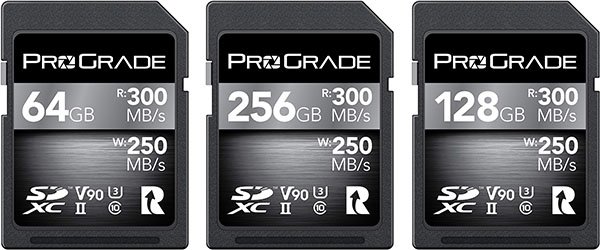
- Bus Type: UHS-II
- Maximum Read Speed: 300 MB/s
- Maximum Write Speed: 250 MB/s
- Minimum Write Speed: 90 MB/s
- Video Rating: V90
- Capacities: 64GB, 128GB, 256GB
In-Camera Speed & Buffer Test Results
Here are my in-camera speed test results using a 64 GB card:
Drive Mode Hi+ (Max 10fps)
Please note that the maximum speed of 10 fps is only possible in compressed RAW, JPEG and HEIF file formats.
| Image Type | Shots Before Hitting Buffer | Time to Clear Buffer (Seconds) |
|---|---|---|
| Uncompressed RAW (70.3MB) – 6 fps | 23 | 4.45s |
| Compressed RAW (36.6MB) – 10 fps | 46 | 4.41s |
| Lossless Compressed RAW L (40.5MB) – 6 fps | 73 | 2.88s |
| JPEG Extra Fine (24MB) – 10 fps | 85 | 2.63s |
Integral UltimaPro X2 UHS-II SDXC

- Bus Type: UHS-II
- Maximum Read Speed: 300 MB/s
- Maximum Write Speed: 280 MB/s
- Minimum Write Speed: 90 MB/s
- Video Rating: V90
- Capacities: 64GB, 128GB, 256GB, 512GB
In-Camera Speed & Buffer Test Results
Here are my in-camera speed test results using a 64 GB card:
Drive Mode Hi+ (Max 10fps)
Please note that the maximum speed of 10 fps is only possible in compressed RAW, JPEG and HEIF file formats.
| Image Type | Shots Before Hitting Buffer | Time to Clear Buffer (Seconds) |
|---|---|---|
| Uncompressed RAW (70.3MB) – 6 fps | 23 | 4.48s |
| Compressed RAW (36.6MB) – 10 fps | 54 | 4.23s |
| Lossless Compressed RAW L (40.5MB) – 6 fps | 109 | 2.76s |
| JPEG Extra Fine (24MB) – 10 fps | 132 | 2.69s |
Check Price & Reviews: Integral UltimaPro X2 UHS-II SDXC
At: Amazon
PNY X-PRO 90 UHS-II SDXC

- Bus Type: UHS-II
- Maximum Read Speed: 300 MB/s
- Maximum Write Speed: 280 MB/s
- Minimum Write Speed: 90 MB/s
- Video Rating: V90
- Capacities: 64GB, 128GB, 256GB
In-Camera Speed & Buffer Test Results
Here are my in-camera speed test results using a 64 GB card:
Drive Mode Hi+ (Max 10fps)
Please note that the maximum speed of 10 fps is only possible in compressed RAW, JPEG and HEIF file formats.
| Image Type | Shots Before Hitting Buffer | Time to Clear Buffer (Seconds) |
|---|---|---|
| Uncompressed RAW (70.3MB) – 6 fps | 23 | 4.49s |
| Compressed RAW (36.6MB) – 10 fps | 52 | 4.45 |
| Lossless Compressed RAW L (40.5MB) – 6 fps | 105 | 2.75s |
| JPEG Extra Fine (24MB) – 10 fps | 130 | 2.68s |
Exascend Catalyst UHS-II SDXC

- Bus Type: UHS-II
- Maximum Read Speed: 300 MB/s
- Maximum Write Speed: 280 MB/s
- Minimum Write Speed: 90 MB/s
- Video Rating: V90
- Capacities: 64GB, 128GB
In-Camera Speed & Buffer Test Results
Here are my in-camera speed test results using a 128 GB card:
Drive Mode Hi+ (Max 10fps)
Please note that the maximum speed of 10 fps is only possible in compressed RAW, JPEG and HEIF file formats.
| Image Type | Shots Before Hitting Buffer | Time to Clear Buffer (Seconds) |
|---|---|---|
| Uncompressed RAW (70.3MB) – 6 fps | 23 | 4.60s |
| Compressed RAW (36.6MB) – 10 fps | 52 | 4.45 |
| Lossless Compressed RAW L (40.5MB) – 6 fps | 105 | 2.56s |
| JPEG Extra Fine (24MB) – 10 fps | 130 | 2.67s |
Angelbird AV Pro Mk 2 V90
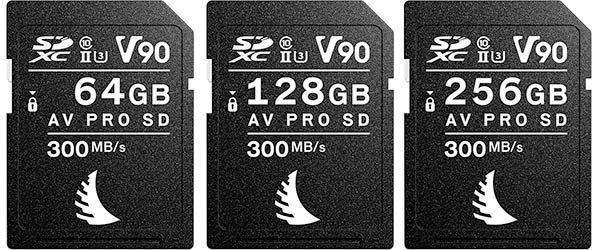
- Bus Type: UHS-II
- Maximum Read Speed: 300 MB/s
- Maximum Write Speed: 280 MB/s
- Minimum Write Speed: 90 MB/s
- Video Rating: V90
- Capacities: 64GB, 128GB, 256GB
In-Camera Speed & Buffer Test Results
Here are my in-camera speed test results using a 64 GB card:
Drive Mode Hi+ (Max 10fps)
Please note that the maximum speed of 10 fps is only possible in compressed RAW, JPEG and HEIF file formats.
| Image Type | Shots Before Hitting Buffer | Time to Clear Buffer (Seconds) |
|---|---|---|
| Uncompressed RAW (70.3MB) – 6 fps | 23 | 4.65s |
| Compressed RAW (36.6MB) – 10 fps | 45 | 4.13s |
| Lossless Compressed RAW L (40.5MB) – 6 fps | 73 | 2.75s |
| JPEG Extra Fine (24MB) – 10 fps | 86 | 2.56s |
Transcend SD 700S UHS-II
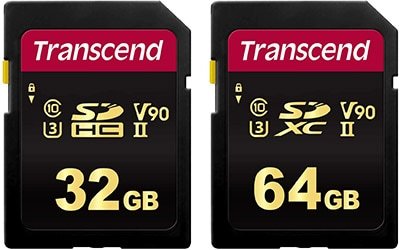
- Bus Type: UHS-II
- Maximum Read Speed: 285 MB/s
- Maximum Write Speed: 180 MB/s
- Minimum Write Speed: 90 MB/s
- Video Rating: V90
- Capacities: 32GB, 64GB
In-Camera Speed & Buffer Test Results
Here are my in-camera speed test results using a 64 GB card:
Drive Mode Hi+ (Max 10fps)
Please note that the maximum speed of 10 fps is only possible in compressed RAW, JPEG and HEIF file formats.
| Image Type | Shots Before Hitting Buffer | Time to Clear Buffer (Seconds) |
|---|---|---|
| Uncompressed RAW (70.3MB) – 6 fps | 23 | 4.65 |
| Compressed RAW (36.6MB) – 10 fps | 28 | 4.11 |
| Lossless Compressed RAW L (40.5MB) – 6 fps | 15 | 2.81s |
| JPEG Extra Fine (24MB) – 10 fps | 25 | 5.70s |
Nextorage NX-F2SE Series UHS-II SDXC

- Bus Type: UHS-II
- Maximum Read Speed: 280 MB/s
- Maximum Write Speed: 170 MB/s
- Minimum Write Speed: 60 MB/s
- Video Rating: V60
- Capacities: 64GB, 128GB, 256GB, 512GB
In-Camera Speed & Buffer Test Results
Here are my in-camera speed test results using a 512 GB card:
Drive Mode Hi+ (Max 10fps)
Please note that the maximum speed of 10 fps is only possible in compressed RAW, JPEG and HEIF file formats.
| Image Type | Shots Before Hitting Buffer | Time to Clear Buffer (Seconds) |
|---|---|---|
| Uncompressed RAW (70.3MB) – 6 fps | 20 | 5.45s |
| Compressed RAW (36.6MB) – 10 fps | 40 | 5.28s |
| Lossless Compressed RAW L (40.5MB) – 6 fps | 32 | 3.40s |
| JPEG Extra Fine (24MB) – 10 fps | 48 | 3.58s |
Sony SF-M Tough UHS-II

- Bus Type: UHS-II
- Maximum Read Speed: 277 MB/s
- Maximum Write Speed: 150 MB/s
- Minimum Write Speed: 60 MB/s
- Video Rating: V60
- Capacities: 64GB, 128GB, 256GB
In-Camera Speed & Buffer Test Results
Here are my in-camera speed test results using a 64 GB card:
Drive Mode Hi+ (Max 10fps)
Please note that the maximum speed of 10 fps is only possible in compressed RAW, JPEG and HEIF file formats.
| Image Type | Shots Before Hitting Buffer | Time to Clear Buffer (Seconds) |
|---|---|---|
| Uncompressed RAW (70.3MB) – 6 fps | 17 | 6.81s |
| Compressed RAW (36.6MB) – 10 fps | 35 | 6.09s |
| Lossless Compressed RAW L (40.5MB) – 6 fps | 25 | 3.71s |
| JPEG Extra Fine (24MB) – 10 fps | 38 | 3.96s |
Very Important Note: Old versions of these cards do not work with the A7 IV. I get a message that says: “Unable to use Memory Card. Slot 1″. Sony has a replacement program for older versions of these cards due to VSC mode (Video Speed Class) issues where recorded footage on the card may be damaged or may not be recorded optimally. I have three cards that I never got around to sending back that don’t work at all in the A7 IV, but work fine in all of my other Sony cameras. New cards purchased from the second half of 2020 should not be affected, and my cards purchased this year work fine. You can find out if your cards are affected by checking this article.
Sony SF-M UHS-II

- Bus Type: UHS-II
- Maximum Read Speed: 277 MB/s
- Maximum Write Speed: 150 MB/s
- Minimum Write Speed: 60 MB/s
- Video Rating: V60
- Capacities: 64GB, 128GB, 256GB
In-Camera Speed & Buffer Test Results
Here are my in-camera speed test results using a 64 GB card:
Drive Mode Hi+ (Max 10fps)
Please note that the maximum speed of 10 fps is only possible in compressed RAW, JPEG and HEIF file formats.
| Image Type | Shots Before Hitting Buffer | Time to Clear Buffer (Seconds) |
|---|---|---|
| Uncompressed RAW (70.3MB) – 6 fps | 17 | 6.81s |
| Compressed RAW (36.6MB) – 10 fps | 35 | 6.09s |
| Lossless Compressed RAW L (40.5MB) – 6 fps | 25 | 3.71s |
| JPEG Extra Fine (24MB) – 10 fps | 38 | 3.96s |
Very Important Note: Old versions of these cards do not work with the A7 IV. I get a message that says: “Unable to use Memory Card. Slot 1″. Sony has a replacement program for older versions of these cards due to VSC mode (Video Speed Class) issues where recorded footage on the card may be damaged or may not be recorded optimally. I have three cards that I never got around to sending back that don’t work at all in the A7 IV, but work fine in all of my other Sony cameras. New cards purchased from the second half of 2020 should not be affected, and my cards purchased this year work fine. You can find out if your cards are affected by checking this article.
ProGrade V60 UHS-II
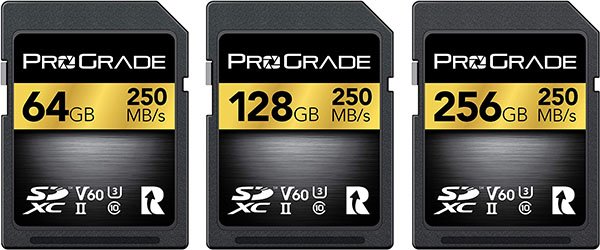
- Bus Type: UHS-II
- Maximum Read Speed: 250 MB/s
- Maximum Write Speed: 130 MB/s
- Minimum Write Speed: 60 MB/s
- Video Rating: V60
- Capacities: 64GB, 128GB, 256GB
In-Camera Speed & Buffer Test Results
Here are my in-camera speed test results using a 64 GB card:
Drive Mode Hi+ (Max 10fps)
Please note that the maximum speed of 10 fps is only possible in compressed RAW, JPEG and HEIF file formats.
| Image Type | Shots Before Hitting Buffer | Time to Clear Buffer (Seconds) |
|---|---|---|
| Uncompressed RAW (70.3MB) – 6 fps | 17 | 7.13s |
| Compressed RAW (36.6MB) – 10 fps | 33 | 6.85s |
| Lossless Compressed RAW L (40.5MB) – 6 fps | 24 | 3.91s |
| JPEG Extra Fine (24MB) – 10 fps | 35 | 4.24s |
Angelbird AV Pro MK2 V60 UHS-II SDXC

- Bus Type: UHS-II
- Maximum Read Speed: 300 MB/s
- Maximum Write Speed: 280 MB/s
- Minimum Write Speed: 60 MB/s
- Video Rating: V60
- Capacities: 64GB, 128GB, 256GB, 512GB, 1TB
In-Camera Speed & Buffer Test Results
Here are my in-camera speed test results using a 64 GB card:
Drive Mode Hi+ (Max 10fps)
Please note that the maximum speed of 10 fps is only possible in compressed RAW, JPEG and HEIF file formats.
| Image Type | Shots Before Hitting Buffer | Time to Clear Buffer (Seconds) |
|---|---|---|
| Uncompressed RAW (70.3MB) – 6 fps | 15 | 10.15s |
| Compressed RAW (36.6MB) – 10 fps | 30 | 9.28s |
| Lossless Compressed RAW L (40.5MB) – 6 fps | 17 | 5.83 |
| JPEG Extra Fine (24MB) – 10 fps | 28 | 6.01s |
Sony SF-E UHS-II
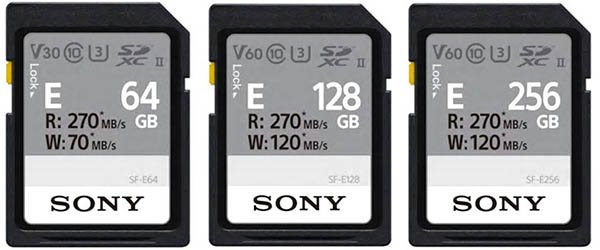
- Bus Type: UHS-II
- Maximum Read Speed: 270 MB/s
- Maximum Write Speed: 70 MB/s (64GB), 120 MB/S (128GB/256GB)
- Minimum Write Speed: 30 MB/s
- Video Rating: V30
- Capacities: 64GB, 128GB, 256GB
In-Camera Speed & Buffer Test Results
Here are my in-camera speed test results using a 64 GB card:
Drive Mode Hi+ (Max 10fps)
Please note that the maximum speed of 10 fps is only possible in compressed RAW, JPEG and HEIF file formats.
| Image Type | Shots Before Hitting Buffer | Time to Clear Buffer (Seconds) |
|---|---|---|
| Uncompressed RAW (70.3MB) – 6 fps | 15 | 13.03s |
| Compressed RAW (36.6MB) – 10 fps | 27 | 12.00s |
| Lossless Compressed RAW L (40.5MB) – 6 fps | 17 | 8.25s |
| JPEG Extra Fine (24MB) – 10 fps | 26 | 7.98s |
Lexar Professional 1667X UHS-II
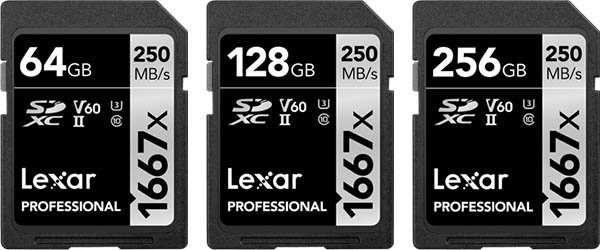
- Bus Type: UHS-II
- Maximum Read Speed: 250 MB/s
- Maximum Write Speed: 120 MB/s
- Minimum Write Speed: 60 MB/s
- Video Rating: V60
- Capacities: 64GB, 128GB, 256GB
In-Camera Speed & Buffer Test Results
Here are my in-camera speed test results using a 64 GB card:
Drive Mode Hi+ (Max 10fps)
Please note that the maximum speed of 10 fps is only possible in compressed RAW, JPEG and HEIF file formats.
| Image Type | Shots Before Hitting Buffer | Time to Clear Buffer (Seconds) |
|---|---|---|
| Uncompressed RAW (70.3MB) – 6 fps | 15 | 14.01s |
| Compressed RAW (36.6MB) – 10 fps | 27 | 8.95s |
| Lossless Compressed RAW L (40.5MB) – 6 fps | 17 | 5.91s |
| JPEG Extra Fine (24MB) – 10 fps | 25 | 5.66s |
Best UHS-I Memory Cards
The A7IV does also support the slower UHS-I memory cards. So if you are not shooting a lot of continuous bursts and filling the buffer quickly, you can save a few extra dollars by purchasing these cheaper cards instead.
Delkin Devices Advantage SDXC UHS-I

- Bus Type: UHS-I
- Maximum Read Speed: 80 MB/s
- Maximum Write Speed: 100 MB/s
- Minimum Write Speed: 30 MB/s
- Video Rating: V30
- Capacities: 64GB, 128GB, 256GB
In-Camera Speed & Buffer Test Results
Here are my in-camera speed test results using a 64 GB card:
Drive Mode Hi+ (Max 10fps)
Please note that the maximum speed of 10 fps is only possible in compressed RAW, JPEG and HEIF file formats.
| Image Type | Shots Before Hitting Buffer | Time to Clear Buffer (Seconds) |
|---|---|---|
| Uncompressed RAW (70.3MB) – 6 fps | 15 | 11.38s |
| Compressed RAW (36.6MB) – 10 fps | 28 | 11.20s |
| Lossless Compressed RAW L (40.5MB) – 6 fps | 17 | 7.90s |
| JPEG Extra Fine (24MB) – 10 fps | 27 | 7.25s |
SanDisk Extreme Pro UHS-I
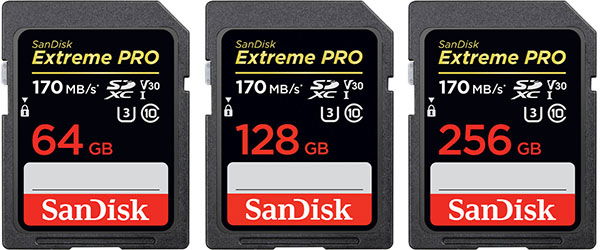
- Bus Type: UHS-I
- Maximum Read Speed: 170 MB/s
- Maximum Write Speed: 90 MB/s
- Minimum Write Speed: 30 MB/s
- Video Rating: V30
- Capacities: 64GB, 128GB, 256GB
In-Camera Speed & Buffer Test Results
Here are my in-camera speed test results using a 64 GB card:
Drive Mode Hi+ (Max 10fps)
Please note that the maximum speed of 10 fps is only possible in compressed RAW, JPEG and HEIF file formats.
| Image Type | Shots Before Hitting Buffer | Time to Clear Buffer (Seconds) |
|---|---|---|
| Uncompressed RAW (70.3MB) – 6 fps | 15 | 14.25s |
| Compressed RAW (36.6MB) – 10 fps | 27 | 13.45s |
| Lossless Compressed RAW L (40.5MB) – 6 fps | 16 | 8.90s |
| JPEG Extra Fine (24MB) – 10 fps | 26 | 9.18s |
SanDisk Extreme UHS-I

- Bus Type: UHS-I
- Maximum Read Speed: 150 MB/s
- Maximum Write Speed: 70 MB/s
- Minimum Write Speed: 30 MB/s
- Video Rating: V30
- Capacities: 64GB, 128GB, 256GB
In-Camera Speed & Buffer Test Results
Here are my in-camera speed test results using a 64 GB card:
Drive Mode Hi+ (Max 10fps)
Please note that the maximum speed of 10 fps is only possible in compressed RAW, JPEG and HEIF file formats.
| Image Type | Shots Before Hitting Buffer | Time to Clear Buffer (Seconds) |
|---|---|---|
| Uncompressed RAW (70.3MB) – 6 fps | 15 | 15.66s |
| Compressed RAW (36.6MB) – 10 fps | 26 | 13.55s |
| Lossless Compressed RAW L (40.5MB) – 6 fps | 16 | 8.98s |
| JPEG Extra Fine (24MB) – 10 fps | 25 | 9.71s |
Memory Card Readers
If you decide to purchase a CFexpress Type-A card or a UHS-II card, then you will also need a compatible memory card reader unless you connect your A7 IV directly to your computer. Here are some of the options available.
ProGrade Digital CFexpress Type A USB 4.0 Single-Slot Card Reader

The CFexpress Type A USB 4.0 Single Slot-Card Reader from ProGrade Digital features a single CFexpress 4.0 Type A slot that supports up to 40 GBits per second (5 GB/s). A magnetic base can be used to secure the reader to your Windows or Mac system. A 2.6′ USB 4.0 cable is included.
Sony MRW-G2 CFExpress Type-A Card Reader
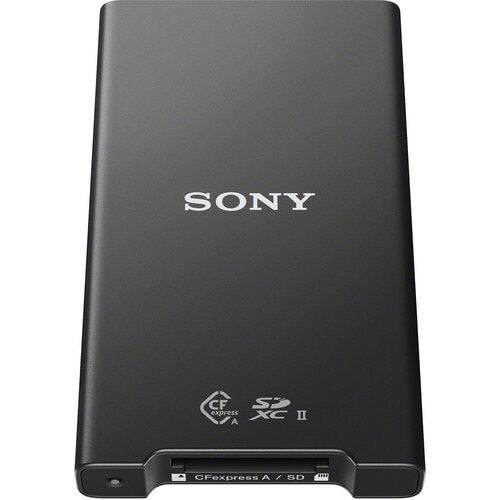
The Sony MRW-G2 supports both CFexpress Type A cards as well as a SD/SDHC/SDXC cards, along with transfer speeds of up to 10 Gb/s via USB 3.1 Gen 2. Both USB Type-C to Type-C and USB Type-C to Type-A cables are included.
ProGrade Digital CFexpress Type A & UHS-II SDXC Dual-Slot USB 3.2 Gen 2 Card Reader
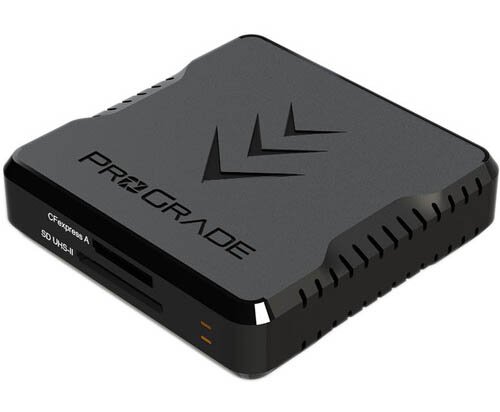
The ProGrade Digital reader has basically the same specs as the Sony MRW-G2 reader but comes at a cheaper price. It has one CFexpress Type A slot and one UHS-II SDXC slot, and also support up to 10 Gb/s via USB 3.2 Gen 2 to deliver transfer speeds of up to 1.25 GB/s, or 1250 MB/s via its USB Type-C interface. It includes USB Type-C to Type-C and Type-C to Type-A cables.
Sony MRW-S1 UHS-II USB Memory Card Reader/Writer
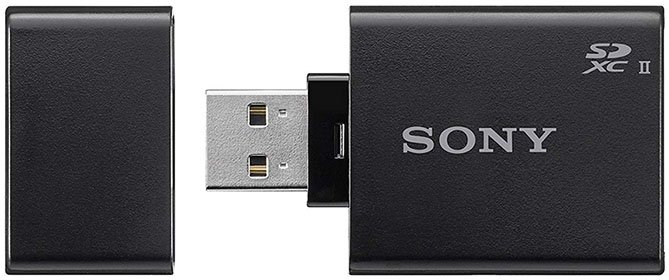
The Sony MRW-S1 UHS-II USB SD Card Reader/Writer can read/write to UHS-II SD Cards via a USB 3.1 interface and is backward compatible with UHS-I SD cards. The Sony MRW-S1 used together with Sony SF-G cards will transfer files to and from your computer around 2.6x faster than UHS-I SD cards.
Kingston MobileLite Plus USB 3.2 SDHC/SDXC UHS-II Card Reader (MLP)
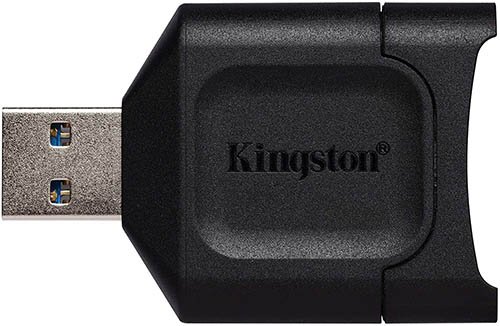
This UHS-II SD card reader features a fast USB 3.2 Gen 1 interface and supports both UHS-II and UHS-I cards.
Memory Cards for Recording Video
The Sony A7IV supports a number of different movie recording formats. The format that you choose to record in will determine the memory cards that you use. Here’s a list or supported recording formats and compatible memory cards for the A7IV.
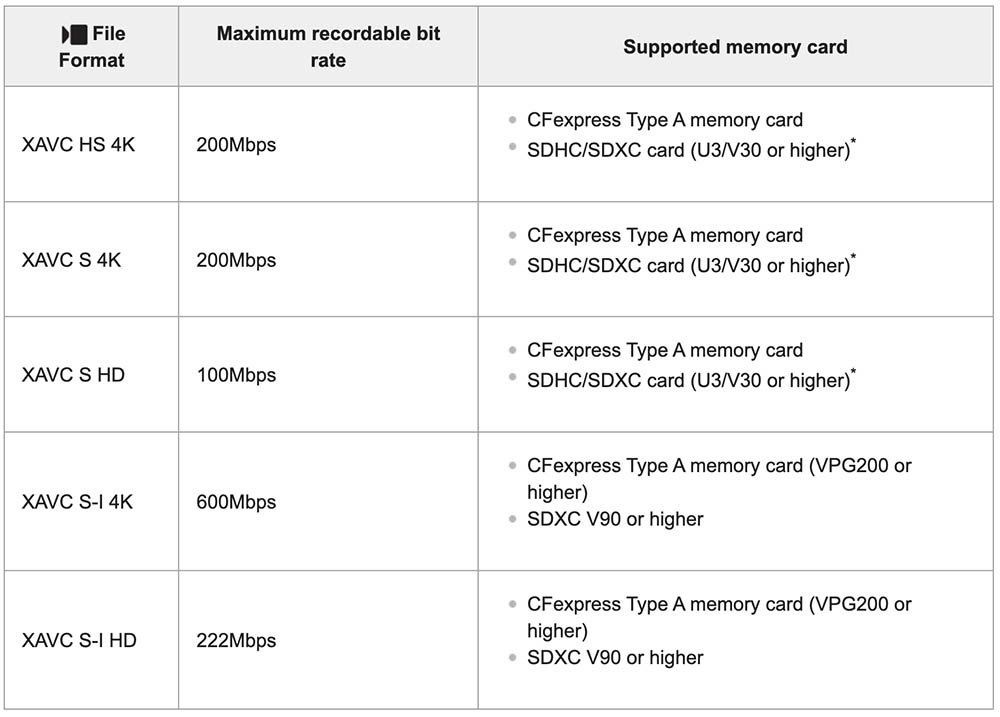
Memory Cards for S&Q Motion Shooting
Here you can find a list of supported recording formats and compatible memory cards for S&Q motion shooting with the A7IV.
You will only require a CFexpress Type-A card when shooting in S&Q Mode with the file format set to XAVC S-I 4k, a record frame rate of 25p and a frame rate of 50fps (2x slow motion).
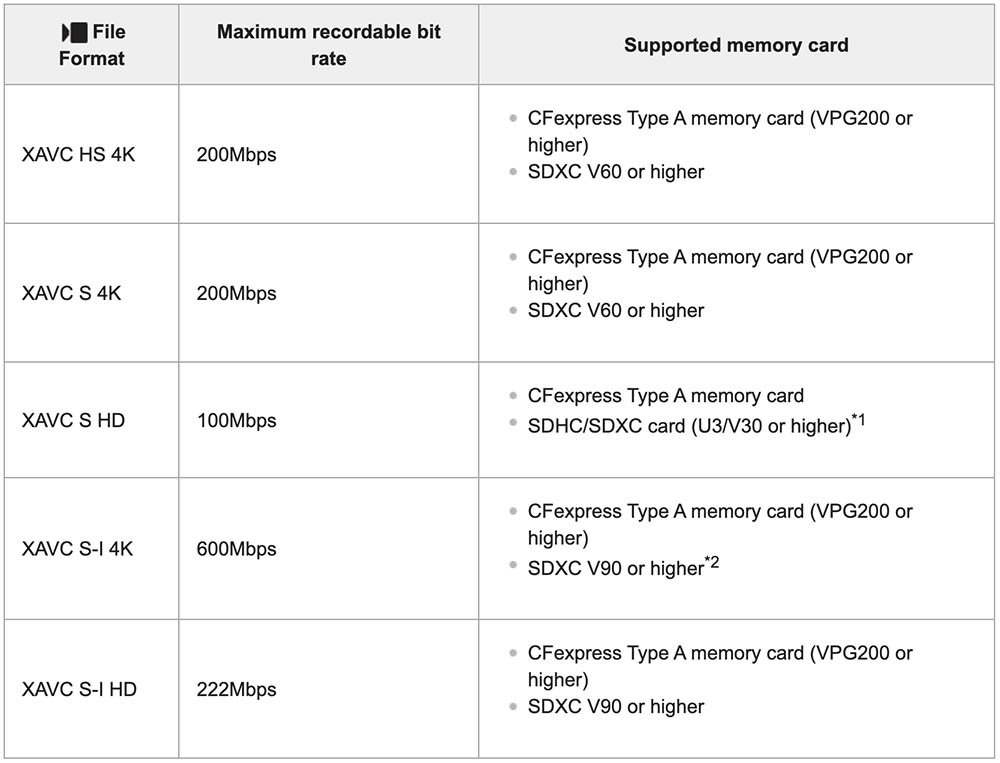
*1 When [Rec Frame Rate] is set to [30p]/[25p]/[24p], [Frame Rate] is set to [120fps]/[100fps], and the recordable bit rate is set to 50 Mbps, an SDXC card (V60 or higher) or a CFexpress Type A memory card (VPG200 or higher) is required.
*2 When [Rec Frame Rate] is set to [30p]/[25p]/[24p] and [Frame Rate] is set to [60fps]/[50fps] for slow-motion recording, a CFexpress Type A memory card (VPG200 or higher) is required.
What Size Memory Card Do You Need?
If you will be shooting a lot of continuous bursts then you will probably want to use at least a 160GB CFexpress card.
If you are not shooting long continuous bursts then you’ll probably be fine with 32GB or 64GB cards and you certainly won’t need the faster CFexpress Type A cards.
For shooting video the size of memory card will depend largely on the format that you are recording in. Or you may be using an external recorder anyway so this won’t be so important.
I’d recommend only using SDXC cards and not SDHC. 32GB cards and smaller are SDHC and use the FAT32 file system. If you shoot video with a SDHC card your files will be split into 4GB chunks which creates extra work in post production.
The following tables will help you to better understand what size cards you need.
How Many Images Can Be Recorded on a Memory Card?
The table below shows the approximate number of images that can be recorded on a memory card formatted in the A7IV when using a Sony memory card with the aspect ratio set to 3:2 and JPEG/HEIF size set to L:33M.
The values may vary depending on the shooting conditions and the type of memory card used.
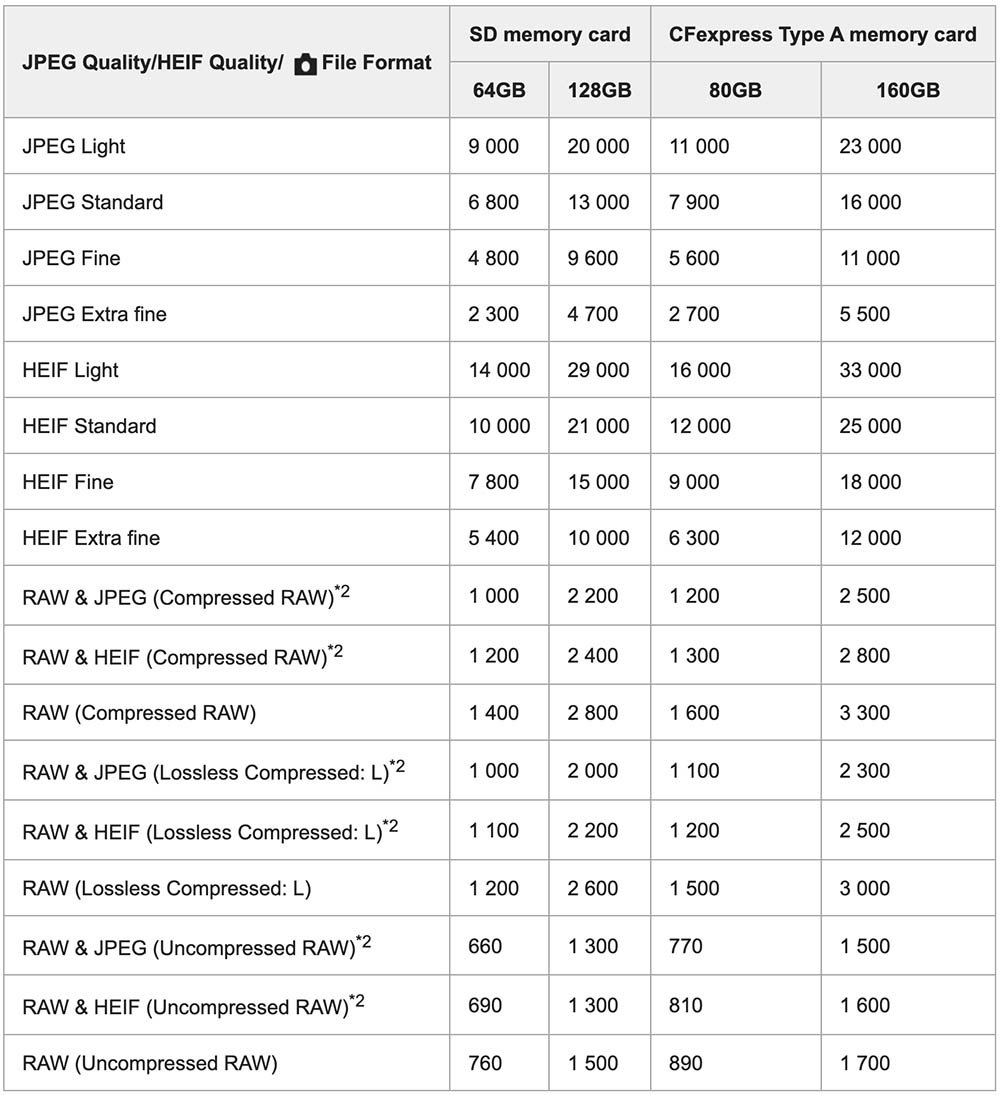
Movie Record Times
The table below shows the approximate total recording times using a Sony memory card formatted in the Sony A7IV. The values may vary depending on the shooting conditions and the type of memory card used.

Simultaneous Recording Slot 1 + Slot 2
If you want to record simultaneously to both slots 1 and 2 at the same time then there is no benefit to using a CFexpress Type-A memory card in slot 1.
With this setup the write speed is restricted to the maximum write speed of the UHS-II card in slot 2. So if you shoot like this often you can save money by using UHS-II cards in slot 1 instead of CFexpress Type-A.
The only benefit to using a CFexpress Type-A card when shooting simultaneously is to enjoy the faster read times when copying the files to your computer.
Providing you are using identical UHS-II cards in both slots then the number of shots that you can take and the buffer clearing time will be the same as writing to a single slot. If one of the UHS-II cards is slower then you will be limited to the speed of that card.
Sort RAW / JPEG
You can also setup your A7 IV to record RAW files to slot 1 and JPEG files to slot 2. With this setup there is still a benefit to using a CFexpress card in slot 1.
Dual Card Setup Guide
If you are not sure how to setup dual card recording with the Sony A7 IV then you might find my short video guide helpful.
Summary
If you shoot a lot of continuous bursts and want the buffer to clear as fast as possible, then you’ll want to use a CFexpress Type-A card in slot one.
All of the CFexpress Type-A cards that I’ve tested perform very well in-camera. You can comfortably shoot 500+ uncompressed RAW images without hitting the buffer.
This is because the A7IV only writes at around 420 MB/s when shooting uncompressed RAW images, so none of the CFexpress Type A cards tested here will struggle.
To see these cards tested a little harder please visit my Sony A1 Memory Card Guide where they will reveal their weaknesses.
All of the V90 rated UHS-II SDXC cards perform very well, but unlike the CFexpress Type A cards you will hit the buffer after around 23 uncompressed RAW images. The buffer will clear in around 4-5 seconds.
The Angelbird AV Pro Mk 2 V90 and Transcend SD 700S UHS-II both perform well when shooting in uncompressed RAW format, but they slow down dramatically when shooting in the other image formats, I’d recommend avoiding these cards.
If you want to shoot in S&Q Mode with the file format XAVC S-I 4k, a record frame rate of 25p/30p and a frame rate of 50fps /60fps then you will need a CFexpress Type A card. The A7 IV will not let you record in this specific format with a V90 card.
Alternatively you could record in one of the none S&Q video formats such as 4k60 XAVCS and then interpret the footage in post. Of course you won’t be able to view the S&Q footage in camera and this is an extra post processing step, but now you won’t require a CFexpress card and you’ll also get audio since recording in S&Q disables the audio.
It would be good to hear about what cards you are using in your own A7 IV and whether or not you have run into any problems with them. Please let me know in the comments below.
Table of Contents[Hide][Show]
- Quick In-Camera Card Speed Comparison
- Which Memory Cards are Supported?
CFexpress Type-A Memory Card Buffer Tests+−
- Nextorage NX-A1PRO CFexpress Type A
- Delkin Devices BLACK CFexpress Type A 4.0
- Angelbird AV PRO CFexpress 2.0 Type A SE
- Lexar Professional CFexpress Type-A Gold Series
- ProGrade Digital CFexpress 4.0 Type A Iridium
- OWC Atlas Pro CFexpress 4.0 Type A
- Pergear Standard CFexpress Type A
- Angelbird AV PRO CFexpress 4.0 Type A
- Sony CEA-G Tough CFexpress Type-A
- Lexar Professional CFexpress Type A Silver Series
- Delkin Devices BLACK CFexpress Type-A
- Delkin Devices POWER CFexpress Type-A
- ProGrade Digital CFexpress Type-A Cobalt
- Sony CEA-M Tough CFexpress Type A
- ProGrade Digital CFexpress 2.0 Type A Gold
- Exascend Essential CFexpress Type-A
- Pergear Prime CFexpress Type A
- Pergear Master 4.0 CFexpress Type A
- Nextorage NX-A1SE CFexpress Type A
- Nextorage NX-A2SE CFexpress Type A
UHS-II SD Memory Card Buffer Tests+−
- Delkin Devices BLACK V90 UHS-II SDXC
- Sony SF-G Tough UHS-II SDXC
- Delkin Devices 64GB POWER UHS-II SDXC
- SanDisk Extreme Pro UHS-II SDXC (300/300)
- OWC Atlas Ultra UHS-II SDXC
- Nextorage NX-F2PRO Series UHS-II SDXC
- Lexar Professional 2000X UHS-II
- Kingston Canvas React Plus UHS-II SDXC
- ProGrade V90 UHS-II
- Integral UltimaPro X2 UHS-II SDXC
- PNY X-PRO 90 UHS-II SDXC
- Exascend Catalyst UHS-II SDXC
- Angelbird AV Pro Mk 2 V90
- Transcend SD 700S UHS-II
- Nextorage NX-F2SE Series UHS-II SDXC
- Sony SF-M Tough UHS-II
- Sony SF-M UHS-II
- ProGrade V60 UHS-II
- Angelbird AV Pro MK2 V60 UHS-II SDXC
- Sony SF-E UHS-II
- Lexar Professional 1667X UHS-II
- Memory Cards for Recording Video
- Memory Cards for S&Q Motion Shooting
- What Size Memory Card Do You Need?
- How Many Images Can Be Recorded on a Memory Card?
- Movie Record Times
- Simultaneous Recording Slot 1 + Slot 2
- Sort RAW / JPEG
- Dual Card Setup Guide
- Summary
- FAQs
- Sony A7 IV Guides & Resources
FAQs
The Sony A7IV supports CFexpress Type A memory cards in slot 1 only. UHS-I and UHS-II SD cards are also supported in both slot 1 and slot 2.
Sony A7 IV Forum & Facebook Group
If you are looking for further help and advice on the a7 IV or would simply like to share your photos and videos, then please head over to our friendly full-frame Forum. If you prefer Facebook then we also run the Sony A7 IV Shooters Group.


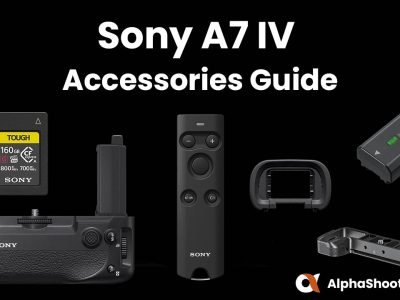
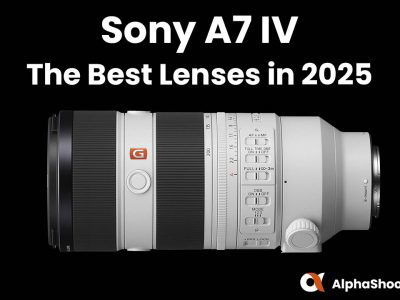
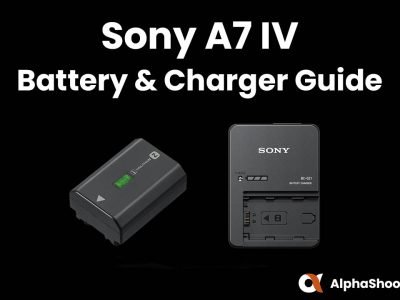
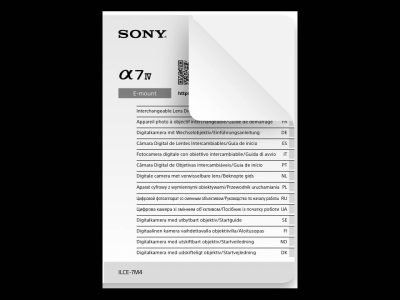
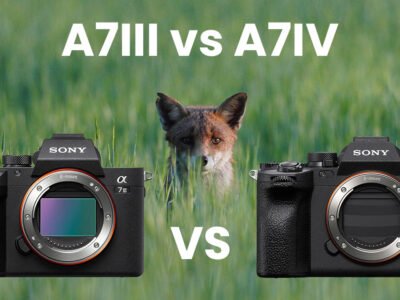

Thanks for this. I’m interested in the methodology behind your benchmarks and how you arrive at the average speeds. Can you share the details behind it? My math is (shots till buffer * file size)/time to clear looks off and exceeds the rated speeds. I get a lot of Chinese brands come my way and wanted to get some numbers.
Anyway, I’ve been holding off on getting CFX-A cards because of the price and I personally prefer shooting with a Ninja but some shoots really benefit from the S&Q modes which happens to require the CFX cards. Anyway, just checked-out some 256GB Kingston Canvas Reacts thanks to your recommendation. The free card reader and a 10$ cashback were a nice bonus 🙂
Hi Richard. Sorry for the slow reply. Yes you basically shoot until the buffer is full and record the total time taken to fill and clear the buffer. To calculate the average in-camera write speed I just take the number of shots taken, multiply this by the file size, then divide by the total time taken to shoot and clear the buffer. I normally repeat this 3x and average the results. Hope you are enjoying the Kingston card! 🙂
No worries and thanks for the reply. Almost forgot about it but I’m not shopping for my first CFx Type-A card and I’m back to your excellent guide. I’ve been meaning to get the Sony Tough cards since they’re the only imports I can get from a nearby country (Japan). I was curious about the “Tough” branding. Is it really as tough as they claim it to be?
THANK YOU SO MUCH fot this test !
i was disappointed abut the performance from my cam with my 170mb/s card..in a ahop they showed me aanother cam with the much more expensive 300mb/s card. and the camera slowed down nearly similar to mine. i thought
got fooled by advertising.i read somewhere abut 800 pictures in burst mode. they didn´t tell me that a cfexpress solves the problem. your test showed it clearly to me so i decided to buy cfexpress and i am happy now 🙂 searched for this information with google and came here 🙂
That to hear that the article helped Thomas! 🙂
Hi Timothy Mayo,
Thanks for the detailed review of all possible options. Its sad that the CFExpress doesnt have many options and its quite expensive to start with.
Does the CFExpress need o have a seprate card reader to copy into harddrive/PC?
Hi Ravi. Yes you will need a CFexpress Type-A reader to read the cards, or you can connect your camera directly to your computer via the USB cable. Hopefully we’ll see more CFexpress Type-A cards released this year and the prices start to come down.
> If you want to shoot in S&Q Mode with the file format XAVC S-I 4k, a record frame rate of 25p/30p and a frame rate of 50fps /60fps then you will need a CFexpress Type A card. The a7 IV will not let you record in this specific format with a V90 card.
Is this still the case with latest firmware? Everywhere I read that v90 UHS-II cards are good enough for shooting all video formats?
The a7 IV is still on its release firmware 1.00, no firmware updates have yet been released. If you shoot in S&Q mode with the settings mentioned above then yes you will need a CFexpress card. You’ll find this mentioned in the a7IV Online Manual and I’ve tested it. Alternatively you could record in one of the none S&Q video formats such as 4k60 XAVCS and then interpret the footage in post. Of course you won’t be able to view the S&Q footage in camera and this is an extra post processing step, but now you won’t require a CFexpress card and you’ll also get audio since recording in S&Q disables the audio.
Hi, thank you for your hard work.
I like to shoot 10 pictures /s. Can I use in slot A CFexpress Type A with uncompressed raw and in slot B SDXC UHS-II with jpeg? Greetings Raoul
Thank you Raoul. When shooting uncompressed raw you will always be limited to 6 frames per second with the a7 IV (see my a7 IV fps guide). You would need to shoot in compressed raw to achieve the maximum 10 fps. If you use a CFexpress Type-A card in slot 1 for the raw images and a fast UHS-II memory card such as the Kingston Canvas React Plus in slot 2 for the jpegs (shooting in sort mode) then you won’t hit the buffer. A slower UHS-II card like the Sony SF-M cards will hit the buffer after around 56 shots when shooting jpegs to slot 2. If you view the buffer data above you just need to pick a UHS-II card that doesn’t hit the buffer when shooting jpegs. Hope that helps!
Brilliant article Timothy. I’m now buying CFexpress as I want to get the top quality video recording option.
Superb level of detail here thank you.
Hello! Thank you for the great info. I am wondering if you can record straight into a Compact SSD via usb-c cable. This is how I do it on my black magic and was noticing it isn’t mentioned anywhere that the A7 IV accepts this function. Thank you!
Unfortunately recording onto an SSD drive via USB-C is not supported with the a7 IV. It would be nice if Sony’s add this to their future cameras though!
Great article Tim. After reading it, I purchased the Kingston v90 128GB SD card for my A7III. When comparing with my Lexar v60 1000x SD card, I don’t see much difference in camera. In fact, I actually got more burst shots with the Lexar in one of my test. I also used Blackmagic Disk Speed Test on my M1 MacBook Pro to test both the cards. I got W60/R151 on the Lexar which is pretty close to their advertised speed of W75/R150. However, the Kingston only got W173/R162, which is no where close to the W260/R300 advertised. Did I purchase a faulty/fake card?
Hi David. If you check my Sony a7III memory card guide you’ll see that the Kingston Canvas React Plus UHS-II don’t perform quite so well in the a7III as they do in the a7 IV. I’ve not tested the Lexar v60 1000x in the a7III but I did test the Lexar Professional 1667X UHS-II which was slower in-camera than the Kingston Canvas React Plus UHS-II. I don’t typically test the external read/write speeds as these vary quite a lot to the in-camera speeds. In-camera speeds also vary by camera model and sometimes even firmware versions. The Sony SF-G tough cards were pretty slow in the a7III until firmware 4.0 was released, then it looks like Sony quietly made some tweaks. Still, it’s strange that your much slower Lexar card isn’t as fast as the Kingston in-camera. If you bought it from a authorized reseller then it’s unlikely to be fake.
Thanks for the quick reply Tim. I ordered the A7 IV but it hasn’t arrived yet. In your opinion, is the Kingston Canvas React Plus UHS-II v90 worth it or should I just keep using my Lexar 1000x UHS-II v60?
If you already have the Kingston Canvas React Plus UHS-II v90 then I’d wait and see how it performs in your a7 IV when it arrives. Also wait and see how the Lexar 1000x UHS-II v60 performs. It depends what and how you are shooting but you might find that the Lexar is fast enough for your needs.
I had planned on getting two cards and recording RAW to slot 1 and JPEG to slot 2. I keep re-reading the section above and I’m still a little confused. If I put a CFe into slot 1 and a UHS-II into slot 2 (like the kingston), the buffer would never be hit?
You’d mentioned that the write speed of the entire system is slowed to the slowest card. Does this just mean that as long as the second slot never backs up with JPEGs, that the first slot would never hit the buffer with a CFe recording RAW? Another way to phrase that question is that the first slot is not held to write speed of the second slot… it’s just that the entire system is slowed if either card hits the buffer limit?
Sorry for the slow reply Ryan. Yes that’s correct. If you use a CFexpress Type-A card in slot 1 and a fast UHS-II SD Card like the Kingston in slot 2 you will not hit the buffer if you have it setup to record either uncompressed raw or compressed raw to slot 1 and jpegs to slot 2. Sorry for the confusion, I might need to re-word the article. You will be limited to the speed of the slowest card when you are shooting simultaneously, so if you wanted to shoot raw to slot 1 and slot 2 you would be limited by the speed of the UHS-II card. With sorting RAW/JPEG it’s not an issue because the buffer is never hit shooting jpegs anyway, providing the UHS-II card is fast enough.
Hi,Timothy,Thank you for this. I was wondering if I shoot S&Q XAVC-SI 1080P 120FPS which is the only fomat that could give me 422 10 bit, what’s the sd card requirement?
Hi there! I recently just got the A7IV and am coming from an A7III. When I put my TOUGH G Series – 128GB SDXC UHS-II Memory Card into the A7IV I get a message that the memory card is unusable and I cannot move past this message or get into the menu. I moved the card to slot 2 and I am able to get into the menu but when I go to format the card it states that format is disabled. Any idea why this is happening and how can I be able to use my cards in the A7IV? Thanks for the help!
Hi John. I mentioned in the article that some older Sony SF-G and SF-M cards might not work in the a7 IV, a few of mine don’t. Sony has a memory replacement program for a different issue, which I suspect is what’s causing the problem in the a7 IV. Unless they are brand new cards?
Hi Tim! Thank you for the reply. The cards were purchased back in 2018 and are part of the affected batch with the serial number starting with TV. I did end up ordering 1 new card and will proceed to swap out my other 2 cards via the replacement program. I was hoping it was something I over looked or missed and the fix would be easy. In any case I’ll provide an update once the new card is received. Thanks again for the reply!
Back again! Trying to make the decision between the Sony Tough Series G vs M. It seems like the M does everything the G does except the very highest quality of video similar to the CF Express. Did you notice any difference in photo performance between the two? I just want to make sure I order the right cards the first time. I was also curious if the G Series may have some benefit with updates down the road. Right now I am currently thinking two 64GBs as it will be mainly used for photos. It maybe be used for hobby and family memories videos a little bit down the road.
Thanks!
Welcome back Brandon! 🙂 I’ve tested a bunch of cards in-camera today and my recommendation for a UHS-II card would be the Kingston Canvas React Plus UHS-II SDXC Memory Card, they normally include a UHS-II card reader as well. The Kingston cards write in-camera at 246 MB/s which is only 1 MB slower than the Sony SF-G Tough cards but they are around 40% cheaper for a 64GB card. The Sony SF-M cards write in camera at 152 MB/s vs 247 MB/s for the SF-G cards. Hope that helps!
Hey Tim, you didn’t mention 24fps and 25fps. Are these frame rates supported? If yes, how long can one expect to shoot for at 200mbps and 100mbps on a 128gb USH-II card?
Thanks for the information. If I buffer the same photo file format to a CFe card in slot 1 and a UHS-ii card in slot 2 at the same time, will the clear speed be slowed down to the speed of the UHS-ii card?
Hi Jake. Although I wouldn’t like to confirm 100 percent until I’ve tested this myself, this will most likely be the case I’m afraid. So if you want to shoot simultaneously to both slots then you will be limited by the maximum speed of the UHS-II card in slot 2. In which case there is little benefit to using a CFexpress Card in Slot 1 other than faster read times when copying files from this card. This is how it works now with the a7III when you shoot simultaneously to both slots, if you put a UHS-II card in slot 1 and a UHS-I card in slot 2, you are restricted by the slower card. That said, the a7 IV has such a large buffer and you can also still access the menu items whilst the buffer is being written to, so you may not even need a CFexpress card anyway.
Thanks for the reply! I think a previous comment didn’t show up. Anyways, I think it would be a hefty investment for you to test out the CFe card, but that would be great!
By the way, did you ever go and test out Kingston cards? Just curious from reading a comment on one of your Youtube videos.
They definitely aren’t the cheapest cards and this probably won’t change anytime soon with only Sony and ProGrade making them right now 🙁 I’d much rather Sony use the CFexpress Type B cards that Canon is using in the R5, they are both faster and cheaper. I do have a Kingston card now but haven’t had chance to test it yet, it is on my to-do list though.
Hey Timothy,
Ultimately if you don’t use a CFExpress Type A card, what features are you loosing with this camera? I have heard the max will be 10fps and maybe some kind of higher video quality? Can you still shoot 4K 60p without it? It’s been difficult to find this exact information.
Hi Brandon. Thanks for your comment! I believe the only feature that you would not be able to take advantage of would be S&Q Mode with XAVC S-I 4K 600Mbps when the [Rec Frame Rate] is set to 30p/25p/24p and [Frame Rate] set to 60fps/50fps for slow-motion recording, this is the only time that a CFexpress Type A memory card is required. At least it is according to the Sony a7 IV Online Help Guide. A lot of the information from the article can be found there. Here’s the link: https://helpguide.sony.net/ilc/2110/v1/en/contents/TP0002911140.html – Although I’ll also be testing this myself when my own a7 IV turns up just to be sure it’s correct. You can certainly still shoot stills at 10fps with just an SD card. If you shoot in 4k 60p and select the most demanding format (XAVC S-I 4K (600Mbps) you can still either use either an SDXC V90 rated SD card or a CFexpress Type A card. I hope that helps!
That is really interesting! I’ve now got my Sony a7iv and stumbled upon this.
But what is the cause for the need of CFExpress?
It is the same bitrate of 600Mbps as when shooting 60fps with XAVS-I 4K….
Hi Matthias. To be honest I don’t know why it doesn’t work, but it’s what it says in the manual and if you try these particular settings with a V90 card it won’t work and you’ll get a message asking you to insert a CFexpress card. It’s a little odd because if I select XAVC S-I 4k, a record frame rate of 25p and a frame rate of 50fps (PAL) then record for 10 seconds I get a 670mb file, so it’s recording at 67MB/s. Even if I change to NTSC and 30p/60fps and again record for 10 seconds I get a 805mb file, so now it’s recording at 80.5MB/s which is comfortably within the capabilities of a V90 card. What I’ve also noticed is that the bitrate drops to 250M (PAL) and 300M (NTSC) with these settings. If you could actually select 600M then the CFexpress requirement would make sense.
Thanks for this. I will use your links to buy. Is there any benefit to the type A cards for video on the a7iv?
Hey Matt. The only benefit to using the CFexpress Type A cards for video would be for their faster read speeds when copying files from them. Even if you shoot in XAVC S-I 4K and 60fps (600M 4:2:2 10bit) you’ll only need a v90 rated SDXC UHS-II card. Hope that helps and thanks for using the links! 🙂
Hi again Matt. Sorry I forgot to mention the S&Q Mode. So if you are shooting in S&Q Mode with XAVC S-I 4K 600Mbps and the [Rec Frame Rate] is set to 30p/25p/24p and [Frame Rate] is set to 60fps/50fps for slow-motion recording, then this is the only time that a CFexpress Type A memory card is required. I’ve added some further details to the article on the memory cards required for each setting.